Methods of Separation in Everyday Life NCERT Class 6th Science Chapter 9 Question Answer
Methods of Separation in Everyday Life Class 6 Questions and Answers
Question 1.
A small amount of puffed rice is mixed with chana dal. Can you think of separating the mixture by any method other than handpicking? (Page 165)
Answer:
Yes, the other method is winnowing.
Question 2.
Valli is unable to separate husk from rice in a closed room. How can you help her? (Page 166)
Answer:
We can help her by placing a fan for air blowing the light husk.
Question 3.
Have you ever observed sieves being used at construction sites to separate pebbles and stones from the sand? (Page 167)
Answer:
Yes, large sieves are used for such purpose.
Question 4.
Have you ever observed white patches on the dark coloured clothes you wear during hot summers? How are these patches formed? (Page 168)
Answer:
Yes, these patches are formed due to evaporation of water from sweat leaving behind salt.
![]()
Question 5.
Observe the figure. Does it answer the question? Can you name the process involved?
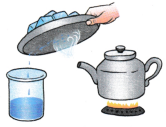
Answer:
Yes, it answer the question. The process involved is condensation.
Question 6.
In the chapter ‘Materials Around Us’, you have studied that oil does not mix with water and forms a separate layer when left undisturbed for some time. Which method of separation would you use to separate oil and water?
Answer:
Decantation process.
Let Us Enhance Our Learning (Page 178 – 180)
Question 1.
What purpose does handpicking serve in the process of separation?
(i) Filtration
(ii) Sorting
(iii) Evaporation
(iv) Decantation
Answer:
(ii) Sorting
Question 2.
Which of the following substances are commonly separated using the churning method?
(i) Oil from water
(ii) Sand from water
(iii) Cream from milk
(iv) Oxygen from air
Answer:
(iii) Cream from milk
Question 3.
Which factor is usually essential for the filtration?
(i) Apparatus size
(ii) Presence of air
(iii) Pore size
(iv) Temperature of the mixture
Answer:
(iii) Pore size
Question 4.
State with reason(s) whether the following statements are True [T] or False [F]. Also, correct the False statements).
(i) Salt can be separated from ‘ salt solution by keeping it under the Sun.
(ii) Handpicking should be used only when the quantity of one component is less.
(iii) A mixture of puffed rice and rice grains can be separated by threshing.
(iv) A mixture of mustard oil and lemon water can be separated by decantation.
(v) Sieving is used to separate a mixture of rice flour and water.
Answer:
(i) True
Reason : The water will evaporate leaving the salt behind.
(ii) True
Reason: It is easier to handpick small quantities.
(iii) False
Reason: Process of threshing is used to separate the grains from the stalks.
Correct statement: This mixture can be separated by handpicking or winnowing.
(iv) True
Reason: The oil and water will form separate layers which can be decanted.
(v) False
Reason: Sieving is done to separate solid-solid mixture of different particles size.
Correct Statement: Filtration is used to separate a mixture of rice flour and water.
Question 5.
Match the mixtures in Column I with their method of separation in Column II.

Answer:
| Column I | Column II |
| (i) Gram flour mixed with black gram | (d) Sieving |
| (ii) Chalk powder mixed with water | (e) Filtration |
| (iii) Corn mixed with potatoes | (a) Handpicking |
| (iv) Iron powder mixed with sawdust | (b) Magnetic separation |
| (v) Oil mixed with water. | (c) Decantation |
Question 6.
In what situations wouldyou use decantation instead of filtration to separate solids from liquids?
Answer:
Decantation is used when the solid particles are heavy and settle down at the bottom of the container, allowing the clear liquid to be poured off without disturbing the solid sediment. For example separating sand from water.
![]()
Question 7.
Can you relate the presence of nasal hair to any separation process?
Answer:
Nasal hair acts like a natural filter, trapping dust, pollen, and other particles from the air we breathe, similar to how a filtration process works to remove solid impurities from a liquid.
Question 8.
During the COVID-19 pandemic, all of us wore masks. Generally, what material are they made of? What is the role of these masks?
Answer:
Masks are generally made of materials like cotton, synthetic fibers, or polypropylene. Their role is to filter out airborne particles, including viruses and bacteria, to prevent their inhalation and spread.
Question 9.
A mixture containing potatoes, sctlt and sawdust has been given to you. Outline a stepwise procedure for separating each component from this mixture.
Answer:
Step-1 : Handpick the potatoes
Step-2 : Add water to the remaining mixture to dissolve the salt
Step-3 : Filter the mixture to separate the sawdust from the salt solution.
Step-4 : Evaporate the water from the salt solution to obtain the salt.
Question 10.
Read the following story titled ‘Intelligent Leela’ and tick the most appropriate options. Protnde a suitable title of your choice for the paragraph.
Leela was working in the farm with her father when she realised that they left their drinking water at home. Before her father felt
thirsty/hungry
, she went to the nearby pond to fetch some
water/ grains
. After obtaining some water in the container, she noticed that the water was muddy and
fit/unfit
for drinking. To purify the water, she kept it for some time and then she
filtered/churned
the muddy water using a piece of
paper/ muslin cloth
. Leela, then,
cooled/ boiled
the water for about 10 minutes in a covered pan. After
cooling/boiling
, she
filtered/churned
it again and made it
fit/unfit
for drinking. She served this water to her father while having food, who blessed her and appreciated her efforts.
Answer:
1. Thirsty
2. Water
3. Unfit
4. Filtered
5. Muslin Cloth
6. Boiled
7. Cooling
8. Filtered
9. Fit
Title – Leela’s Clever Solution for Clean Water
NCERT Solutions for Class 6 Science Chapter 9 The Living Organisms and Their Surroundings
Topics and Sub Topics in Class 6 Science Chapter 9 The Living Organisms and Their Surroundings:
| Section Name | Topic Name |
| 9 | The Living Organisms Characteristics and Habitats |
| 9.1 | Organisms and The Surroundings Where They Live |
| 9.2 | Habitat and adaption |
| 9.3 | A journey through different habitats |
| 9.4 | Characteristics of organisms |
1. What is a habitat?
Ans: The surroundings where animals live is called their habitat. The organisms depend on their habitat for their food, water, air, shelter and other needs. Habitat means a dwelling place.
2. How are cactus adapted to survive in a desert?
Ans: Cactus are adapted to survive in a desert as they have
(i) No leaves or spiny leaves to prevent water loss through transpiration.
(ii) Stem is modified in such a way that it performs photosynthesis and conserves water.
(iii) Their roots go very deep into the soil for absorbing water.
3. Fill in the blanks:
(a) The presence of specific features which enables a plant or an animal to live in a particular habitat is called___________ .
(b) The habitats of the plants and animals that live on land are called _________________ habitats.
(c)The habitats of plants and animals that live in water are called ____________________ habitats.
(d) Soil, water and air are the____________ factors of a habitats.
(e) Changes in our surroundings that make us respond to them are called
Ans:
(a) adaptation
(b) terrestrial
(c) aquatic
(d) abiotic
(e) stimuli
4. Which of the things in the following list are non-living?
Ans: Plough, Mushrooms, Sewing machine, Radio, Boat, Water, Hyacinth, Earthworm. Plough, Sewing machine, Radio, Boat and water are non-living.
5. Give an example of a non-living thing which shows any two characteristics of living thing.
Ans: Example of non-living thing is cloud which shows following two characteristics of living things:
(i) It grows in size
(ii) It shows movement.
6. Which of the following non-living things were once part of a living thing?
Butter, Leather, Soil, Wool, Electric Bulb, Cooking Oil, Salt, Apple, Rubber.
Ans: Butter, Leather, Wool, Cooking oil, Apple and Rubber are the non-living things which were once part of a living thing.
7. List the common characteristics of living things.
Ans: Some common characteristics of living things are:
- Growth
- Movement
- Reproduction
- Respiration
- Responsiveness
- Excretion
8. Explain why speed is important for survival in the grasslands for animals that live there. (Hint: There are few trees or places for animals to hide in grasslands habitats).
Ans: In grasslands habitats, there are few trees or places for animals to hide. When their enemy attacks they have to run faster so as to reach a safe place. If they fail, they lose their life. So, the speed is very important for survival of grassland animals.
Class 6 Science Chapter 9 VERY SHORT ANSWER TYPE QUESTIONS
1. Name some plants found on mountains.
Ans: Oaks, Pinus and Deodars.
2. What is habitat?
Ans:. The place where organisms live and which provide food and safety for them is ‘called habitat.
3. Name a few habitats.
Ans: Forests, grassland, mountains, ponds and oceans etc.
4. Name two organisms that live in deserts.
Ans: Cactus, camel, desert rat.
5. Name a few plants that live in ponds.
Ans: Hydrilla, lotus, hyacinth etc.
6. Name the habitat where various types of fish live.
Ans: Pond, river, sea.
7. Name a common thing in all fishes.
Ans: Gills, streamlined body, fins, tail.
8. What is the function of gill?
Ans: Gills help the fish to absorb oxygen dissolved in water.
9. Name the animal which is called the ship of desert.
Ans: Camel
10. Name various types of habitat.
Ans:
(i) Terrestrial Habitats
(ii) Aquatic Habitats
(iii) Aerial Habitat
11. Name two aquatic animals.
Ans:
(i) Fish
(ii) Tortoise
12. Name two terrestrial organisms.
Ans:
(i) Cat
(ii) Dog
13. Name two examples of aerial habitat animals.
Ans:
(i) Birds
(ii) Mosquitoes
14. Name the types of components of habitat.
Ans: Components of habitat are:
(i) Biotic components
(ii) Abiotic components
15. Give two examples of each biotic and abiotic components.
Ans: Plants and animals are biotic components, air and water are abiotic components.
16. What do you mean by germination of seeds?
Ans: The beginning of a new plant from the seeds is called germination.
17. Does adaptation take place in a short time?
Ans: No, adaptation does not take place in a short time. It takes place in thousands of years.
18. Name few terrestrial habitats.
Ans: Deserts, mountains and grassland.
19. Name some aquatic habitats.
Ans:Oceans, ponds and lakes.
20. What are predators?
Ans: The animals which kill other animals for their food are called predators.
21. What is a prey?
Ans: The animals which are killed by predators for their food are called prey.
22. Name two aquatic animals which have no gills.
Ans: Dolphin and whales.
23. What are blowholes?
Ans: The organs by which dolphin or whales breathe are called blowholes or nostrills.
24. What is photosynthesis?
Ans: The process by which plants make their own food with the help of chlorophyll,sunlight, carbon dioxide and water is called photosynthesis.
25.What is the main Junction of food?
Ans: Food gives energy to the organism which helps them in growth and development.
26. What is breathing?
Ans: The process of taking in oxygen and giving out carbon-dioxide (inhalation and exhalation of air) is called breathing.
27. What is respiration?
Ans: The process in which oxygen is used by the living bodies to break down food to get energy, water and carbon dixode is produced is called respiration.
28. What is stimuli?
Ans: The changes in our surroundings that makes us respond to them are called stimuli.
29. What is excretion?
Ans: The process of getting rid of the waste by the living organisms is known as excretion.
30. Do plants also excrete?
Ans: Yes, plants also excrete.
31. What is reproduction?
Ans: The process by which living organisms produce more of their own kind is called reproduction.
32. Do animals move?
Ans: Yes, animals move from one place to another.
33. Do plants also move?
Ans: Plants are generally fixed in the soil so they do not move from one place to another.
Class 6 Science Chapter 9 SHORT ANSWER TYPE QUESTIONS
1. What are the differences in the desert and sea regions?
Ans: In the sea, plants and animals are surrounded by salty water. Most of them use the air dissolved in water for breathing. In desert, a very little amount of water is available. It is very hot in the day time and very cold at night. The organisms breathe air from the surroundings.
2. What do you mean by term adaptation?
Ans: The presence of specific features or certain habits which enable a plant or an animal to live in its surroundings is called adaptation.
3. Explain the features offish which help it to adapt to live in water.
Ans:
(i) The shape of the fish is streamlined which help in the movement.
(ii) The slippery scales/skin on their bodies to protect them.
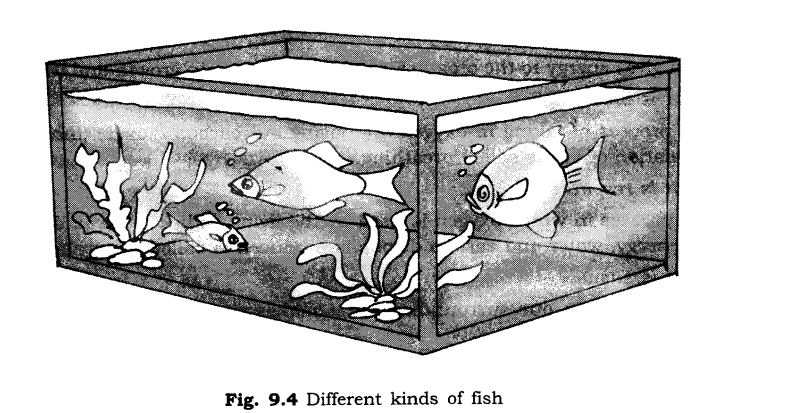
(iii) They have flat fins and tails which help them to swim, change direction and to keep the body balanced.
(iv) They have gills which help in breathing in water.
4. How are camels adapted to live in desert?
Ans: (i) The feet of the camels have thick, flat large soles which help them in the movement on sand.
(ii) They can live without water for a long time. When water is available, it drinks large amount of water at a time.
(iii) They release very little urine to prevent loss of water.
(iv) Their dung is also dry which also helps to prevent loss of water.
(v) The long legs of camel helps to keep the body away from the heat of the sand.
5. What do you mean by acclimatisation?
Ans: The small changes which take place in the body of a single organism over short periods to overcome small problems due to changes in the surroundings are called acclimatisation.
6. Why do we need abiotic factors?
Ans: The abiotic factors like air, water, light and heat are very important for the growth of plants. These abiotic factors are also very important for the growth and the development of animals.
7. How are some animals adapted to live in desert?
Ans: Some animals like rats and snakes do not have the long legs like camels to stay away from the effect of heat during the day. They stay in burrows deep in the sand. They come out only during the night.
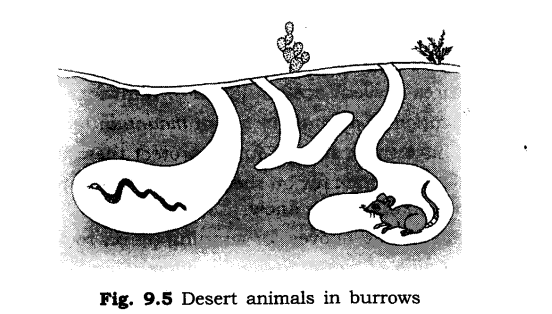
8. Write the features of desert plants.
Ans:
(i) The leaves in desert plants are either absent or very small.
(ii) Leaves are converted into spines which help to reduce loss of water.
(iii) The stems become thick, flat and green which help in photosynthesis.
(iv) The stem is covered with waxy layer which helps to retain water. In some plants stem is spongy and stores water.
(v) The roots go very deep in the soil to absorb water.
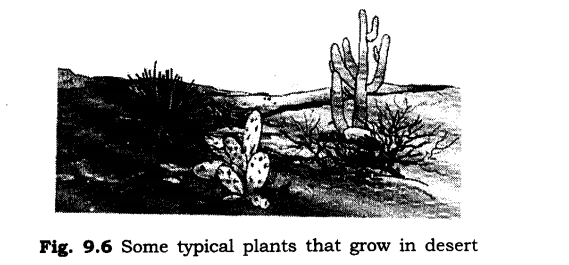
9. Explain the adaptation of trees to live in mountain regions.
Ans:
(i) The shape of the trees is of normally cone type.
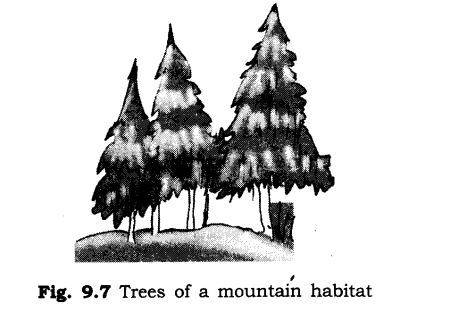
(ii) Branches are sloping.
(iii) The leaves of these trees are needle like.
(iv) These structures prevent accumulation of rainwater and snow over them.
10. Explain the adaptation of animals to live in mountain region.
Ans:
(i) The animals have thick skin or fur to protect them from the cold.
(ii) Some animals have thick fur on their body, feet and toes which protect them from cold on walking in the snow.
(iii) The goats have strong hooves for running up on rocky slopes.
11. Explain the adaptation of plants to live in water.
Ans:
(i) Roots are reduced in size which hold the plant.
(ii) Stems are long, hollow and light.
(iii) Stems grow up to the surface of water.
(iv) Leaves and flowers float on the surface of water.
(v) The leaves are covered by the waxy layer which protects the leaves from excessive water.
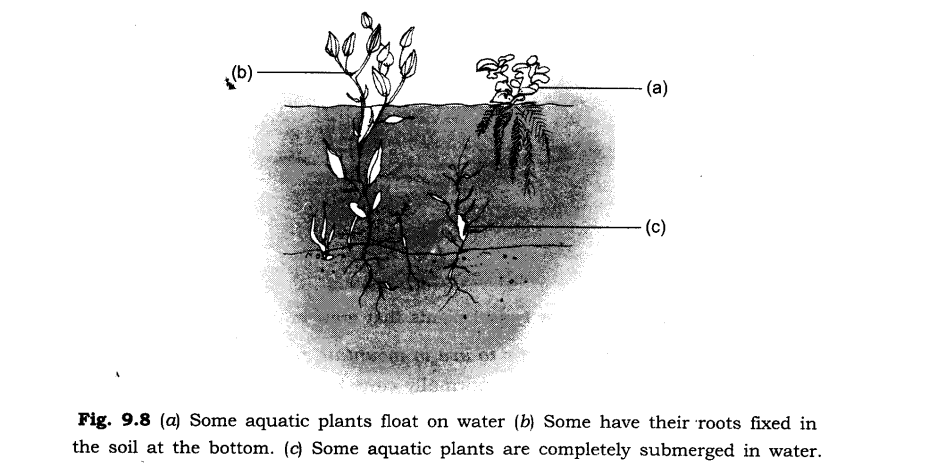
12.What kind of movement do we see in plants?
Ans:
(i) Opening and closing of a flower.
(ii) Growth of a stem and leaves.
(iii) Movement of water, minerals and food from one part of the plant to other.
(iv) Movement of stem towards sunlight and root towards water in the soil.
13. Frogs can live both on land and in water, name the adaptations seen in these animals.
Ans: Frogs have strong back legs that help them in leaping and catching their prey. They have webbed feet which help them to swim in water.
Class 6 Science Chapter 9 LONG ANSWER TYPE QUESTIONS
1.Explain the characteristics oflimng organisms.
Ans. There are following characteristics of living organisms
(i) All living organisms require food. The food gives energy for growth and to maintain other life processes.
(ii) All living organisms show growth. Young ones of animals grow into adults. Plants also grow.
(iii) All living organisms respire. In respiration oxygen is used for the oxidftion of food and carbon dioxide is produced.
(iv) All living organisms respond to stimuli. All plants and animal respond to light, heat and the changes around them.
(v) All living organisms show excretion. The process of getting rid of waste product by the living organisms is called excretion. Plants also remove their wastes.
(vi) All living organisms reproduce. The process by which plants and animals produce their own kind is called reproduction.
2.Write the difference between living and non-living things.
Ans.
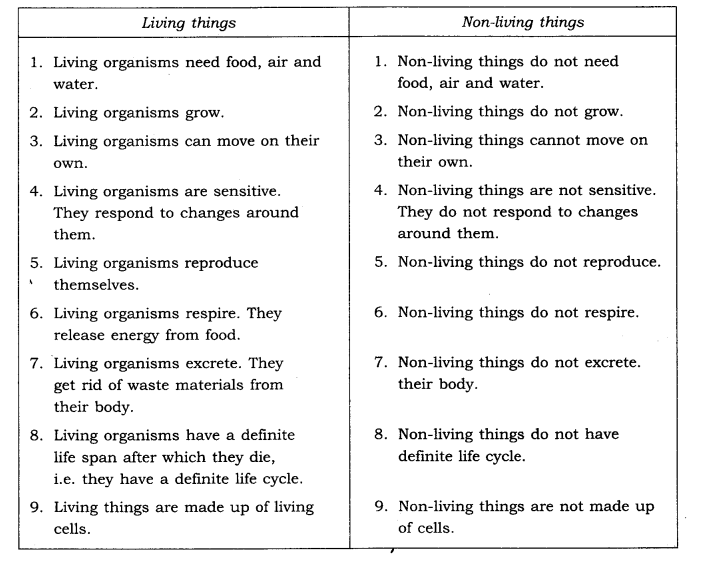
NCERT Solutions for Class 6 Science – All Chapters
- Chapter 1 The Wonderful World of Science
- Chapter 2 Diversity in the Living World
- Chapter 3 Mindful Eating: A Path to a Healthy Body
- Chapter 4 Exploring Magnets
- Chapter 5 Measurement of Length and Motion
- Chapter 6 Materials Around Us
- Chapter 7 Temperature and its Measurement
- Chapter 8 A Journey through States of Water
- Chapter 9 Methods of Separation in Everyday Life
- Chapter 10 Living Creatures: Exploring their Characteristics
- Chapter 11 Nature’s Treasures
- Chapter 12 Beyond Earth